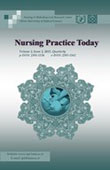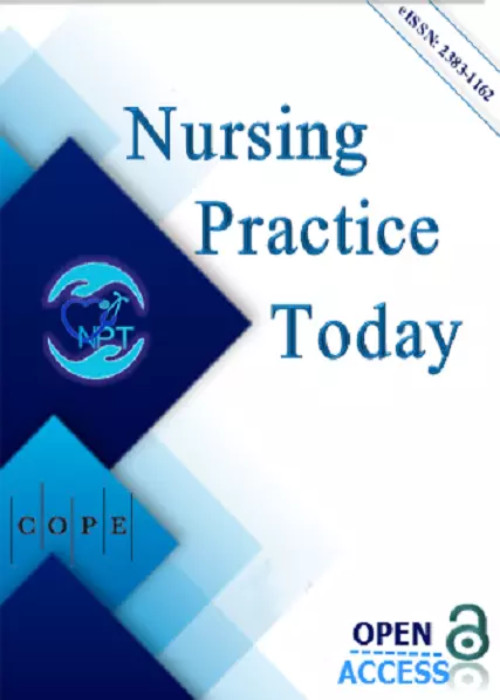فهرست مطالب

Nursing Practice Today
Volume:2 Issue: 2, Spring 2015
- تاریخ انتشار: 1394/05/04
- تعداد عناوین: 6
-
-
Page 41At the time of drafting this editorial, the UK media was reporting an unusual story. A young mother and her 3 years old son were on a busy train in the south of England. A note was given to her by a stranger leaving the train. He left £5 with the note that said: “Have a drink on me.You are a credit to your generation, polite and teaching the little boy good manners.” The young mother was very surprised and said she “wanted to cry.” She also said that the stranger “shows there are still good people out there and I want him to know I am truly grateful”...
-
Page 43Background and AimFear of death can cause death anxiety for everyone. In health care professions, death anxiety becomes a routine source of stress and may lead to unwanted consequences. Coping strategies of nurses and different approaches to death can affect the quality of health care services. The aim of this study was to determine attitudes toward death in nursing staff in hospitals of Rafsanjan.Methods & Materials: This was a cross-sectional study. The population study consisted of 400 (all nursing staff) working in hospitals of Rafsanjan University of Medical Sciences (RUMS) in 2012. The data were collected using demographic and death attitude profile revised questionnaires.ResultsFear of death was significantly higher in women, younger participants with little work experience, those without experience of intensive care unit working, and those without a history of education about death (P < 0.0500). Death escape scores were significantly higher in the age group of 31-35 years. An approach toward death was significantly better in women, those with related training, those older than 46 years, and those with over 20 years of work experience.ConclusionRUMS treatment centers had a favorable attitude toward death in five categories. This is probably due to religious beliefs and looking at death as a bridge to the afterlife.Keywords: death, attitude, area health education centers, hospital, nursing staff
-
Page 52Background and AimThis study aimed to discover the lived experiences of patients transferred from the intensive care unit (ICU) to a general ward, to reach a deeper understanding of this phenomenon.Methods & Materials: This is a qualitative study with an interpretative phenomenological approach, which is conducted at hospitals affiliated to universities, and private hospitals of Tehran in 2013. Eighteen participants were purposefully selected for face-to-face and semi-structured interviews.ResultsThe findings revealed that the ICU patients experienced various feelings during the process of transition to a general ward. In this regard, three main themes were identified: “happiness of return” (consisted of three subthemes: “return to living,” “return to family,” and “return to a general ward”); “separation anxiety” (consisted of two subthemes: “anxiety of separation from the equipment” and “anxiety of separation from ICU staff”); and “spiritual development” (consisted of two subthemes: “being thankful to God” and “well-wishing toward others”).ConclusionThe findings of the present study showed that recognizing and focusing on each patient’s individual needs, emotions, and expectations is essential to provide more holistic and patient- centered care during the process of transition from ICU to a general ward. Accordingly, there is a potential need to develop structured and formal discharge planning in the clinical settings like Iran where this topic has not been touched yet.Keywords: intensive care units, patient discharge, transfer, qualitative research, hermeneutics, nursing
-
Page 62Background and AimNowadays, new methods related to pain management have emerged. However, it has been reported in studies that post-operative pain management is inadequate. The purpose of this study was determined to pain levels of the patients after gynecologic surgery and nursing interventions.Methods & Materials: This descriptive study was undertaken as a multicenter study in the gynecologic surgical departments of the university and state hospital in Samsun. 221 patients who had an operation in first 48 hours post-operative, were participated in the study voluntarily, were included in the study sample. Data were collected by questionnaire and visual analog scale (VAS). Data were evaluated with percentage, mean, Mann–Whitney U and Kruskal–Wallis tests.ResultsIt was determined that the patients were experienced severe pain according to VAS (7.23 ± 2.79). It was found a significant relationship between the pain scores and marital status, smoking habit, and operation length of the patients. It was found that the most common applied nursing pain management intervention were preparing a comfortable and quiet environment and giving information about effects of the disease and drugs. It was found that nurses were not used imagination and music.ConclusionThis study was showed that the patients were experienced severe pain the early period after gynecologic surgeryand that frequency of non-pharmacologic methods of nurses were veryfew in pain management.Keywords: gynecologic surgery, post, operative pain, nursing, non, pharmacologic pain management interventions
-
Page 69Background and AimThe aim of this clinical trial study was to evaluate sleep quality in patients with chronic lung disease and the role of controlled breathing to improve the quality of sleep.Methods & Materials: Sixty-four patients with chronic lung disease in two group (experimental and control group) enrolled in a 7 weeks. Before interventions, the Pittsburgh Sleep Quality Index (PSQI) and the Demographic Information Questionnaire were completed by the samples in the control and intervention groups. Next, the pursed-lip breathing, diaphragmatic breathing and coughing techniques were taught to the experimental group, whereas the control group received the typical treatments. Seven weeks after the breathing exercises the PSQI was once again completed by the samples in the control and intervention groups. The resulting data were analyzed using SPSS.ResultsThe results show that after controlling the differences of mean groups sleep quality scores in pre-exam, the intervention (breathing exercises) has affected on the means of the dependent variable scores (quality of sleep) in post-exam (P < 0.001). In other words, the sleep quality of intervention group has improved.ConclusionThe researcher recommends the administrators, decision makers, and members of treatment groups to use non-pharmacologic methods and incorporate controlled breathing exercises into the sleep management and improvement programs designed for patients with chronic obstructive pulmonary disease.Keywords: chronic obstructive pulmonary disease, sleep quality, controlled breathing exercise
-
Pages 76-83Background and AimWith the implementation of incorrectly airway suctioning, many complications and risks can be followed. Therefore, health care providers can expedite recovery of patients by increasing in quality of suction. This study was conducted to evaluate the effect of clinical audit process on the level of endotracheal tube suctioning skill in nurses and anesthesia technicians working in intensive care units (ICUs) of AJA hospitals in Tehran, Iran.Methods & Materials: In this semi-experimental study, 135 nurses and anesthesia technicians working in ICUs in AJA hospitals in Tehran, Iran recruited by census method and were randomly allocated into two groups of intervention and control, in 2013-2014. The intervention was conducted via implementation of the five-stage clinical audit in the intervention group. For detection of endotracheal tube suctioning skill in subjects, pre- and post-intervention, the checklist was used. Then, data were analyzed using the SPSS version 21.ResultsIn pre-intervention phase, independent t-test not showed significant differences in the mean scores of the subjects’ clinical endotracheal suction skill in two groups (P = 0.7300) but in postintervention phase, two groups were different (P = 0.0001). Paired t-test showed that the total score of nursing skill in endotracheal suction of the subjects in intervention group after the intervention significantly increased (102.38 ± 7.24 to 121.25 ± 2.10, P = 0.0001).ConclusionThe results of this study suggested a positive impact of clinical audit process on nurses and anesthesia technicians’ endotracheal suction skill. Therefore, it seems that the implementation of this process can promote level of nursing care.Keywords: anesthesia, clinical audit, endotracheal, intensive care unit, nurses, clinical skill, suction


